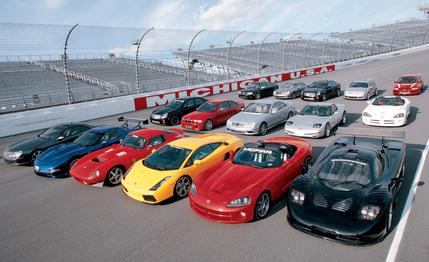 Comparison Tests
Comparison Tests
Our annual tuner-car beat-down, presently called the “Supercar Challenge,” has all the earmarks of becoming a tradition at Car and Driver. It started in September 2001, when we ran six powerful, highly modified cars through a two-day event that we dubbed the “Supertuner Challenge.” It included a day of driving the cars on public roads and a second day at speed-limit-free Michigan International Speedway in Brooklyn, about 40 miles from headquarters in Ann Arbor.
We held the event again in September 2002 but changed the name to the “Supercar Challenge.” Sixteen cars competed that time. In September 2003, we made some significant changes. Although the ’01 and ’02 events were pretty much run-what-you-brung affairs, we invited only fourcylinder cars last year, and instead of hosting them in Michigan, we traveled to Southern California for the “Superfour Challenge.”
This year, we’re back to the original big-dog format. We extended invitations to a varied group of expensive, superstrong cars. In 2003, when we ran the little guys, the average as-tested price for the four-bangers was about $45,000, and the king of the hill claimed 450 horses. Big difference from the current runoff, where the average as-tested price is more than $130,000. Four of our entrants claimed peak power of 750 or more horses.
Need we say it was a carnival of horsepower and torque? As before, we spent day one driving the cars on public roads and rating drivability on a five-star scale (five being best). The second day was spent at Michigan International Speedway, a 2.0-mile banked oval with an infield road course. There we gave each entrant five runs through a modified autocross course (see map, next page).
All runs were timed by our Racelogic VBOX GPS-based test equipment. Each run included a standing-start blast to 60 mph, elapsed time and speed over a quarter-mile, roadcourse time, various data points, and overall time—the last determining the finishing order of the cars. Space limitations prevent us from printing every number of every run, but we’ve posted all the data and more detailed specifications at www.CARandDRIVER.com.
Since we didn’t use our usual procedure for testing acceleration time (for example, we did not make runs in two directions), we didn’t apply our normal weather correction to the times, so be wary when comparing these results to ones from previous road tests. Judging by the day’s weather conditions, we figure the acceleration numbers published here are probably a few 10ths of a second higher than what we’d normally record. And since the test cars represented a range of model years, we used current stock pricing when calculating the cost of each one.
We haven’t quite figured out how to handle emissions compliance. Some companies claimed their cars met EPA regulations; other cars, like the Hennessey Venom and Vishnu Evo, ran without catalytic converters, devices that clean exhaust gases but rob horsepower. We didn’t test the exhaust gases of each car, so we can’t say if any of them met the regulations. But if you live in a state with strict laws like California’s, you’ll want to make sure your chosen tuner can supply a car that meets the regs. Maybe next year we’ll include emissions testing.
This year, we did tweak the rules a bit. As before, the cars were required to run 93-octane gas, and we prohibited the use of nitrous or water injection. We mandated tires that have a minimum tread-wear rating of 140. In previous years, a few competitors who shall remain nameless complained that one winner ran specially made tires that carried the appropriate tread-wear rating molded onto the sidewall but were in fact deviously sticky, one-off specials. We were inclined to let that go, but nonetheless, we ordered this year’s entrants to get their rubber from the Tire Rack, ensuring no cheater tires.
As in the past, the tuners could supply their own drivers or have C/D technical director Larry Webster drive. In the event a driver struck a cone, a fivesecond penalty was added to the score, and if the car was louder than 103 dBA (measured at the side of the track), it was slapped with a 10-second penalty.
Most significant, we divided the cars into two classes: Open and Sedan. A sedan is a car with a back-seat space of 36 or more cubic feet, and an open car works out to, well, anything else. So we have a winner for each class. In addition, we awarded a trophy to the car that posted the quickest time of the day, regardless of class, and called it the John Lingenfelter Memorial Trophy. Lingenfelter was an enthusiastic and determined participant (his cars won in 2001 and 2002) who died last December from injuries sustained in a racing accident. Lingenfelter Performance Engineering carries on, but we all missed John’s energy and intensity at this year’s event.
To make the challenge more interesting, we invited two of the same car. We were successful, winding up with a pair of Corvettes, Vipers, Cadillac CTS- Vs, and Mercedes-Benz SLs, eight of the 16 entrants. Unfortunately, despite our come-on teaser in the June issue, no one stepped forward with a Ferrari Enzo to demonstrate exactly why it is viewed in some circles as the greatest street car ever built.
Still, an impressive group of machinery showed up, and with a few exceptions, all of them ran extremely well. We hope you enjoy the show. —Larry Webster